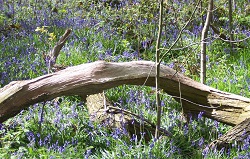
Barbecues are not permitted at any of our sites.
One of the unusual features of Bluebell Wood is the variety of habitats in such a compact site. The eastern section is classed as 'semi-natural ancient woodland' as it has been here since at least 1600. The western section is self-set woodland on a former industrial site. In between is an extremely important area of wet woodland.
Wildlife
The wood has a fantastic array of wildlife, some easy to spot, others not so easy. Many of them are associated with ancient woodland.
The trees include oak, silver birch, hornbeam, field maple, beech and various willows. Smaller understorey trees include hazel, holly and hawthorn.
Wildflowers include wood anemone, marsh marigold, yellow archangel, and, of course, bluebells – visit in spring and you will see thousands of them.
Mammals living in the wood include stoats, weasels, wood mice and voles, with badgers and the occasional deer passing through. At dusk, bats (Noctules, Daubenton's and the tiny Pipistrelles) can be seen in the tree canopy.
There are also large numbers of species of invertebrates, fungi and amphibians.
Woodland management
The range of wildlife species in the wood is increasing as a result of our woodland management work. We work with nature rather than trying to force it to do something it doesn’t want to do. Much of the work is to allow a proper woodland structure to form, from fungi and invertebrates, through wild flowers, shrubs and small trees to large canopy trees.
Deadwood is a vital component of a woodland ecosystem. It is here that much of the life of a woodland begins. In fact, in a completely natural woodland, up to 60% of the wood would be dead therefore, we try to ensure there is plenty of deadwood around, hence the dead standing trees, log piles and brash piles you will notice.
Bluebell Wood Access for All project
Bluebell Wood is now accessible by wheelchair and pushchair and looking at it now it's difficult to imagine just how difficult it was to get around the wood previously. In 2003/4 we began a project driven by the conviction that everyone, whatever their level of ability, should be able to share this beautiful place. The challenge was to achieve this without damaging the woodland and its wildlife. Stiles were replaced by special gates, gradients reduced, and paths rebuilt using local stone. Two narrow timber bridges crossing the stream were replaced by boardwalks.
You can take a wheelchair or pushchair along the whole 1,100m route from Hayfield Countryside Centre and back again. There are 2 ways in from the Sett Valley Trail. The first path into the wood slopes down a little steeper than ideal, but it is manageable. The second is much easier. You can take either direction around the wood, or you can double back and avoid the steeper section. The choice is yours.
Boardwalks
These were designed and built by our countryside service using recycled plastic which would otherwise have lain in a landfill for thousands of years. It will last much longer than treated timber since it will not rot. Also, unlike treated timber, it will not allow harmful chemicals to leach out and damage the surrounding highly sensitive wet woodland habitat. Great care was taken to make sure the structures blend into the landscape rather than being imposed on it.
Bluebell Wood is a special place – please help us keep it that way.